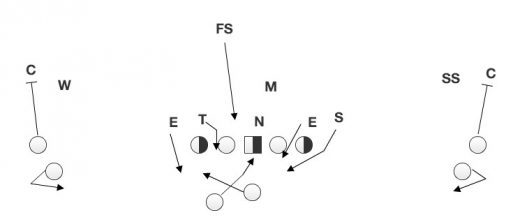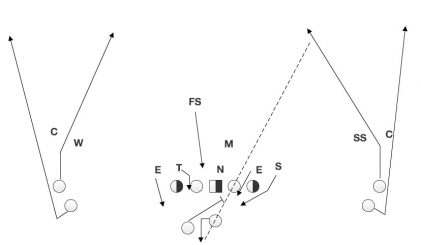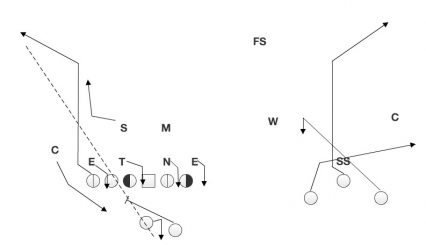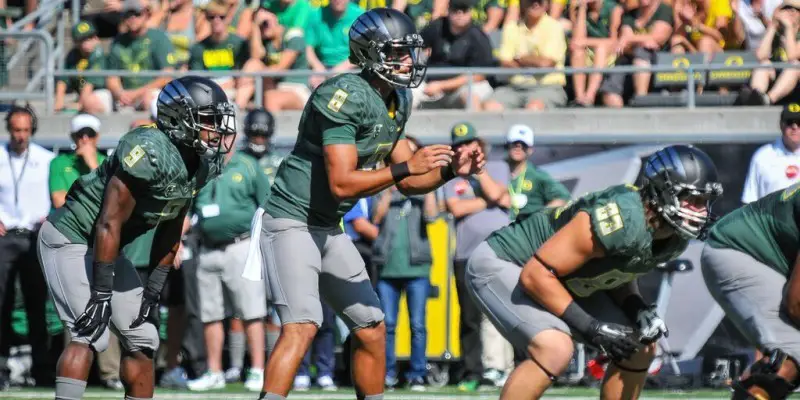Analysts love to dissect Oregon’s many packaged schemes and option runs, offensive plays designed to take advantage of whatever the defense throws at them, with an answer for just about anything and everything. There is, however, another part of any offense that is just as crucial, sometimes referred to as constraint plays.
Constraint plays force a defense to hesitate, to think a little bit longer about what it is they think they’re seeing, and punishes them for laziness and being unprepared.
The basic idea is that the offense will run several plays that start out looking very similar but in fact end up aiming for wildly different things. An example of this is when you see traditional offenses run the power play from out of the I-Formation, then run a play-action pass that looks very similar.
Constraint plays also give an offense like Oregon’s the chance to keep a defense honest, especially when it comes to slowing down the many different run blitzes that opponents try to use to stop the Ducks.
Let’s take a look at a couple of examples.
Play No. 1 —
In this scenario we see Oregon lining up with a balanced formation and no tight end attached to the offensive line. Formations like this one are often used by Mark Helfrich‘s offense to create a large amount of space in the alley, and stretch the structure of the defense from sideline to sideline. As a result, the defense has to send their edge defenders out wide to attempt to take away the hitch screens or pitch men on option plays, leaving a scant number of opposite-color jerseys in the box to defend the run.
You know the rest of the script from here. The offense uses their numbers advantage inside the box to run the ball right up the middle for a solid gain. Rinse and repeat.

The FS comes downhill to help with the run game.
Defensive coordinators know how these things work, as well, which is why they’re constantly trying to add more defenders to the tackle box to get to the ball carrier in a hurry and win the numbers game inside.
On this play, Utah leaves the middle of the field wide open when the free safety reads run, and he flies downhill to attack the run game. The edge rushers end up making the hits in the backfield in this situation, but by flying to make the hit the defense sends a clear message that they will not stand back and allow themselves to be gutted by Marcus Mariota and the prolific Oregon offense.

Tough Sledding…
Next comes the adjustment by this Oregon offense.
Play No. 2 —
Let’s go to another play later on in the game.
By lining up in the same formation once again and giving the defense the same kind of backfield action, Oregon is using a constraint play in this situation.
Not only does the offense line up in another four-receiver set, with two players stacked to each side, but the skill players go out of their way to mimic the action of another zone read play with dual hitch screens on either side. After going through their initial steps for a moment, all four receivers streak down the field to get open.

The offense lines up in a similar look to the previous play and is able to hit the receiver down the seam.
Mariota hits a receiver, whose initial movements allowed him to lose his defenders (if only for a moment) coming down the right hash in the seam.

You-give-we-take!
Thus, Oregon has set themselves up for success by recognizing what the defense was doing, giving their opponent a false impression of what was coming, and completely flipped the script by hitting them in one of their weak spots.
Play No. 3 —
In our final example, we’ll look at Oregon’s answer to one of the most common defensive adjustments they face.
With as many 3×1 formations as the Ducks run, especially with the tight end acting as the single receiver and creating a closed side, one of the defensive strategies they encounter most often is to bring some kind of edge rush from that side in order to turn back any run to the perimeter headed that way.
Many defensive coordinators feel like they can afford to be a little unsound because it’s not often that an offensive coordinator will go out of his way to get the football to the tight end on this side of the formation.
Oregon, however, is not most teams, and if you present a vulnerability, they’ll find it and exploit it.

When the corner blitzes from the tight end side of the formation, the tight end runs wide open down the left sideline.
The Ducks have been waiting for the chance to break some offensive tendencies and, after Mariota carries out the wide zone fake to the left and sees the corner blitzing off the left side, he knows his man is going to be open deep.
To the far right side of the formation, we have a standard route combination, sometimes referred to as a “spot” concept that is used by just about every team in college football, but on this play Mariota knows exactly where he wants to go with the football as soon as he has it in his hands.

Nice to see play-action…
The Ducks hit a big play and march closer to the end zone for an early score in this game.
Conclusion
These are just a couple of limited examples of what this offense is capable of, but thanks to good coaching and preparation, the Oregon offense knows the kinds of formations and plays that will best exploit their opponent on any given week. Not only that, but by giving a defense several different looks that appear similar, and taking advantage of opportunities to break tendencies, the Oregon offense remains one of the toughest in the nation to stop.
I may be in Indiana, but “oh how we love to learn about your beloved Ducks!”
Coach Alex Kirby
Oregon Football Analyst for the CFF Network/FishDuck.com
Indianapolis, Indiana
Top Photo by Kevin Cline
Want to go deep inside the X’s and O’s of the National Championship Game? Alex Kirby has put together a PDF with nearly 250 pages of diagrams and analysis, and has broken down every single play in the game. Click here to get access to this incredible breakdown and have it delivered to your inbox instantly.
On his site, LifeAfterFootballBlog.com, Alex will be offering signed copies of his first two books, “Speed Kills: Breaking Down the Chip Kelly Offense” and “Inside the Auburn Offense.” Alex is also the creator of the site, DrawFootballPlays.com of which provided the diagrams above and is a superb tool for coaches and writers to use in their football diagramming.
Related Articles:
Alex Kirby (Writer and Football Analyst) worked several seasons as an assistant football coach at the high school and college levels and is the author of Speed Kills: Breaking Down the Chip Kelly Offense, now available HERE.

